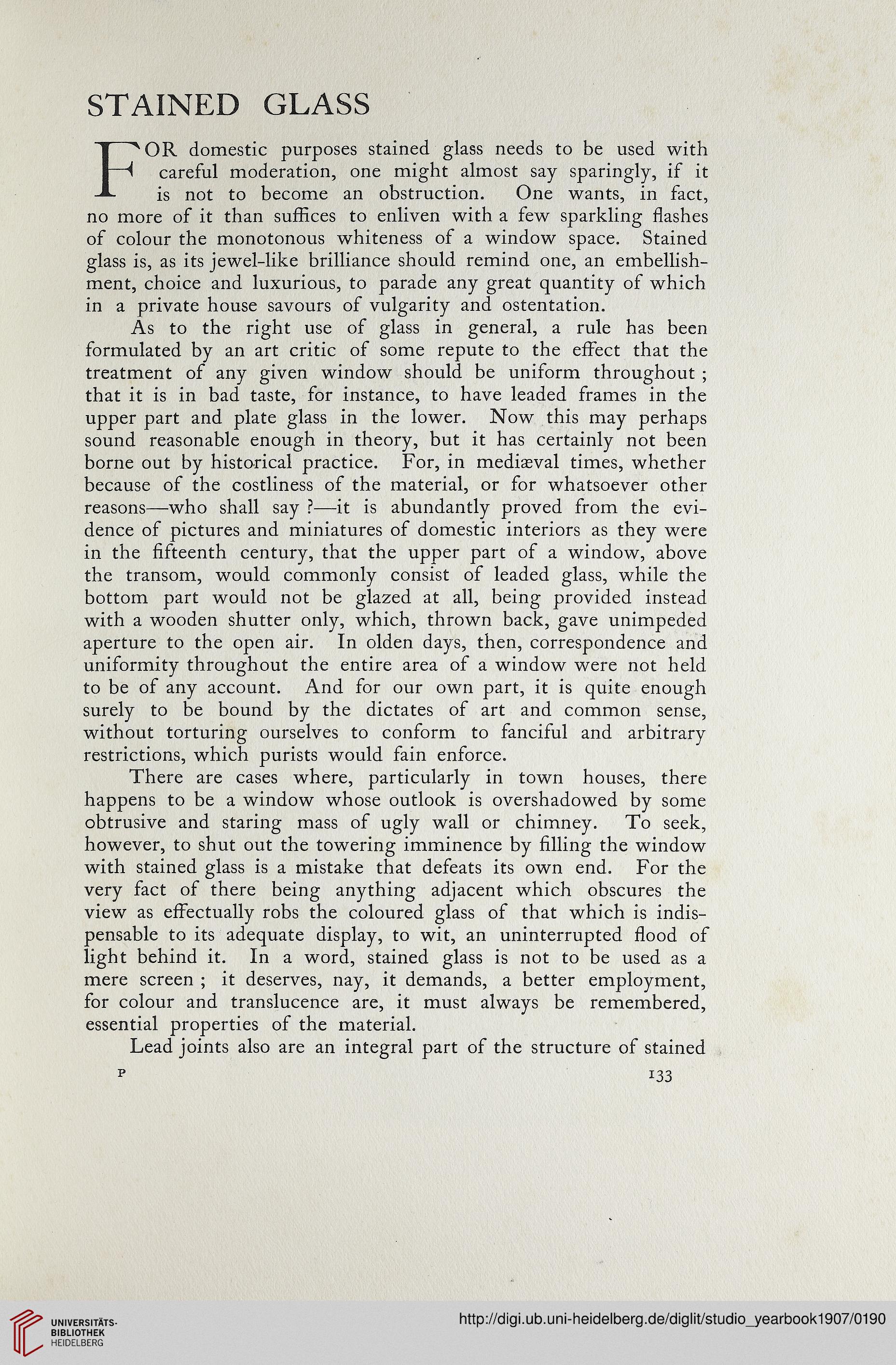STAINED GLASS
OR domestic purposes stained glass needs to be used with
careful moderation, one might almost say sparingly, if it
is not to become an obstruction. One wants, in fact,
no more of it than suffices to enliven with a few sparkling flashes
of colour the monotonous whiteness of a window space. Stained
glass is, as its jewel-like brilliance should remind one, an embellish-
ment, choice and luxurious, to parade any great quantity of which
in a private house savours of vulgarity and ostentation.
As to the right use of glass in general, a rule has been
formulated by an art critic of some repute to the effect that the
treatment of any given window should be uniform throughout ;
that it is in bad taste, for instance, to have leaded frames in the
upper part and plate glass in the lower. Now this may perhaps
sound reasonable enough in theory, but it has certainly not been
borne out by historical practice. For, in medieval times, whether
because of the costliness of the material, or for whatsoever other
reasons—who shall say ?—it is abundantly proved from the evi-
dence of pictures and miniatures of domestic interiors as they were
in the fifteenth century, that the upper part of a window, above
the transom, would commonly consist of leaded glass, while the
bottom part would not be glazed at all, being provided instead
with a wooden shutter only, which, thrown back, gave unimpeded
aperture to the open air. In olden days, then, correspondence and
uniformity throughout the entire area of a window were not held
to be of any account. And for our own part, it is quite enough
surely to be bound by the dictates of art and common sense,
without torturing ourselves to conform to fanciful and arbitrary
restrictions, which purists would fain enforce.
There are cases where, particularly in town houses, there
happens to be a window whose outlook is overshadowed by some
obtrusive and staring mass of ugly wall or chimney. To seek,
however, to shut out the towering imminence by filling the window
with stained glass is a mistake that defeats its own end. For the
very fact of there being anything adjacent which obscures the
view as effectually robs the coloured glass of that which is indis-
pensable to its adequate display, to wit, an uninterrupted flood of
light behind it. In a word, stained glass is not to be used as a
mere screen ; it deserves, nay, it demands, a better employment,
for colour and translucence are, it must always be remembered,
essential properties of the material.
Lead joints also are an integral part of the structure of stained
OR domestic purposes stained glass needs to be used with
careful moderation, one might almost say sparingly, if it
is not to become an obstruction. One wants, in fact,
no more of it than suffices to enliven with a few sparkling flashes
of colour the monotonous whiteness of a window space. Stained
glass is, as its jewel-like brilliance should remind one, an embellish-
ment, choice and luxurious, to parade any great quantity of which
in a private house savours of vulgarity and ostentation.
As to the right use of glass in general, a rule has been
formulated by an art critic of some repute to the effect that the
treatment of any given window should be uniform throughout ;
that it is in bad taste, for instance, to have leaded frames in the
upper part and plate glass in the lower. Now this may perhaps
sound reasonable enough in theory, but it has certainly not been
borne out by historical practice. For, in medieval times, whether
because of the costliness of the material, or for whatsoever other
reasons—who shall say ?—it is abundantly proved from the evi-
dence of pictures and miniatures of domestic interiors as they were
in the fifteenth century, that the upper part of a window, above
the transom, would commonly consist of leaded glass, while the
bottom part would not be glazed at all, being provided instead
with a wooden shutter only, which, thrown back, gave unimpeded
aperture to the open air. In olden days, then, correspondence and
uniformity throughout the entire area of a window were not held
to be of any account. And for our own part, it is quite enough
surely to be bound by the dictates of art and common sense,
without torturing ourselves to conform to fanciful and arbitrary
restrictions, which purists would fain enforce.
There are cases where, particularly in town houses, there
happens to be a window whose outlook is overshadowed by some
obtrusive and staring mass of ugly wall or chimney. To seek,
however, to shut out the towering imminence by filling the window
with stained glass is a mistake that defeats its own end. For the
very fact of there being anything adjacent which obscures the
view as effectually robs the coloured glass of that which is indis-
pensable to its adequate display, to wit, an uninterrupted flood of
light behind it. In a word, stained glass is not to be used as a
mere screen ; it deserves, nay, it demands, a better employment,
for colour and translucence are, it must always be remembered,
essential properties of the material.
Lead joints also are an integral part of the structure of stained





